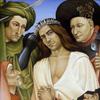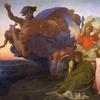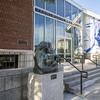Traveling Exhibition 'Paris 1900: City of Entertainment' Debuts in the U.S. This Fall
- NASHVILLE, Tennessee
- /
- August 15, 2018
The Frist Art Museum in Nashville will present Paris 1900: City of Entertainment, an exhibition that revives the splendor of the French capital at the turn of the twentieth century, when millions visited the site of the International Exposition. Organized by the Petit Palais Museum of Fine Arts in Paris with additional loans from other Parisian museums, the exhibition will be on view in the Frist’s Ingram Gallery from October 12, 2018, through January 6, 2019. The Frist is the first of three venues in the United States to present this iteration of an exhibition that was originally on view at the Petit Palais in 2014.
With the International Exhibition of 1900 as its starting point, the exhibition offers a focused look at the different ways in which Paris became the entertainment capital of the world. Belle Époque Paris, a period of relative peace and prosperity stretching from 1874 to 1914, was the site of intense artistic and architectural innovation, which gave rise to entertainment forms that continue to remain relevant.
Bringing together over 250 objects—paintings, prints, sculptures, decorative art, costumes and fashion accessories, posters, photographs, and more—kept mainly by the City of Paris museums, Paris 1900 immerses visitors in the era’s sparkling atmosphere of elegance, pleasure, and festivity. Major artists represented in the exhibition include Pierre Bonnard, Berthe Morisot, Camille Pissarro, Pierre-Auguste Renoir, Auguste Rodin, Henri de Toulouse-Lautrec, and Édouard Vuillard, as well as many others working across multiple mediums.
The exhibition also tells the story of a vibrant and swiftly changing city. Although Paris was quite different from its idealized representation in posters and advertisements, the turn of the century was indeed an exceptional time. The city was growing rapidly and had a population of nearly three million by 1914. Additionally, Paris attracted travelers for both business purposes and leisure activities. “It is fitting that Nashville is the first stop of this exhibition’s tour,” says Frist Art Museum curator Katie Delmez. “Like Paris in 1900, Nashville is also in the process of dramatically transforming itself into not only a national cultural hub, but an international destination for entertainment as well. The similarities are striking. Paris was dealing with infrastructure and traffic challenges and a tremendous construction boom, issues that Nashville is now grappling with.”
The objects will be presented in six groupings: “Paris, Showcase of the World”; “Art Nouveau”; “Paris, Capital of the Arts”; “The Parisian Woman”; “Traversing Paris”; and “Paris by Night.”
The first section, “Paris, Showcase of the World,” introduces visitors to the physical transformations the city underwent leading up to the International Exposition. Architectural drawings and paintings illustrate the building of the city’s first metro line and new train stations, bridges, and buildings like the Petit Palais and Sacré-Coeur.
Perhaps the most emblematic artistic movement of the Belle Époque was Art Nouveau, an international style that drew inspiration from nature and tested the long-established hierarchy of art by valuing forms traditionally considered “minor,” such as bookbinding, posters, and jewelry.
Underscoring the rich variety of artistic movements of the period, “Paris, Capital of the Arts” features works by well-known Impressionist, Symbolist, and Nabis artists along with objects made by less familiar but equally impressive figures such as the female sculptor Camille Claudel and academic painter Paul Émile Chabas.
The creative energy and innovation of the fine art scene influenced the fashion industry. The birthplace of both haute couture and the department store, Paris was unquestionably the capital of the fashion world at the turn of the twentieth century. “The Parisian Woman” section explores the sartorial mastery that captivated and inspired countless artists, artisans, and writers. Advertisements, fashion plates, paintings, costumes and accessories, offer a comprehensive look at the period’s fashion. They include an evening gown designed by Rue Royale couturier Ernest Raudnitz, a velvet cape from Au Bon Marché (the first modern department store), hats by well-known Parisian milliners, button boots, and fans.
The final portion of the exhibition, “Paris by Night,” turns its attention to new forms of leisure and spectacle and the city’s abundant and thriving nightlife. Cinema, the circus, theme parks, and sporting matches were new and popular attractions. Georges Méliès pioneered the industry with films like A Trip to the Moon (1902), the first science fiction film ever made, which is screened here. Cabarets, like the famous Chat Noir (immortalized in Théophile Steinlen’s black cat poster) and Le Moulin Rouge were also attracting large audiences with their dance and music routines. More upper-class venues such as the Théâtre de l’Opéra and restaurants like those depicted in Henri Gervex’s sumptuous painting of elegant restaurant-goers exemplify the vast array of options.
“Paris 1900: City of Entertainment offers a rare and in-depth look into the spirit of joie de vivre that pervaded Paris at the turn of the last century,” says Delmez. “While the burst of optimism and creative energy would be halted with the outbreak of World War I, the exhibition brilliantly captures and retells the period’s long-lasting influence on future generations.”









100x100_c.jpg)



